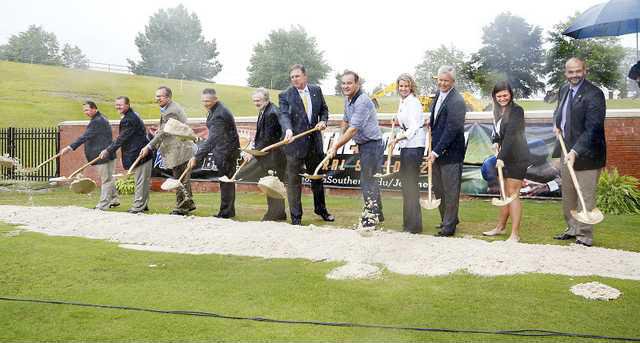There are a number of changes afoot for the Georgia Southern University football team.
The Eagles, with six Football Championship Subdivision national titles and two runner-up finishes, will begin their final year in FCS on Aug. 31, with Savannah State coming to Paulson Stadium.
The changes are about to commence at Paulson, which has been Georgia Southern’s home since the 1984 season. Construction on a $10 million football operations center and an expansion of the stadium are set to begin Wednesday. The new football operations center is being funded privately, and the target date for completion is April 2014.
A student fee increase voted in last year will fund the $10 million stadium expansion, set to be finished in May 2014.
The stadium cost $4.7 million to build 30 years ago.
Georgia Southern announced earlier this year it was leaving the Southern Conference after more than 20 years to move to the Football Bowl Subdivision’s Sun Belt Conference. Regardless if the Eagles had been in the SoCon or the Sun Belt in 2014, the stadium and football building plans were going to go forward, head coach Jeff Monken said.
“We had no idea the Sun Belt move was coming when we made plans to do the stadium and the football operations center,” he said. “It’s perfect timing for us.”
The stadium, which has 14,400 seats, will add more than 6,000 seats to bring the total capacity to more than 20,000. It hasn’t been unusual for the Eagles to play in front of 20,000 or more at home — there were four games with crowds in excess of 20,000 in the 2012 season alone, and annual attendance has averaged more than 19,000 in each of Monken’s three seasons as head coach. There also have been 23 games with at least 20,200 in attendance.
“We average over 20,000 fans a game already,” Monken said. “That’s a lot of people sitting on the grass and standing up behind the stands, and I think that’s the start of what will come in the future.”
The 50,000 square foot football operations center will replace the Parrish Building and will contain locker rooms, meeting rooms, a weight room with a view of the stadium and coaches’ offices. It also will be the new home for the hall of fame exhibits.
Aside from the building projects, the Eagles are going from FCS, with a scholarship limit of 63 players, to FBS, where they will be able to offer up to 85 full scholarships.
“We could go to 85 this year,” Monken said. “But it wouldn’t change the guys on our team.”
Under NCAA rules, the Eagles have to average 76.2 scholarships per year over the next two years. They will be a Sun Belt member in 2014 and be a full-fledged FBS member, with bowl eligibility, in 2015.
“We will take some of those guys on partial scholarship and some of our walk-ons and reward them some more,” he said. “We’ll essentially have the same team as if we had not made the move this fall. We are going to increase the money we are awarding so we do meet the requirements.”
What won’t change, Monken said, is how the Eagles recruit. Even with the changes to Paulson and the football facilities, along with the move to the Sun Belt, the Eagles likely won’t be expanding their recruiting base.
“I don’t know that our recruiting pool changes a lot,” he said. “That’s probably a misperception, that all off a sudden we’re going to jump into an entirely new recruiting pool because we’re moving to FBS.”
The biggest difference, Monken explained, is that now the Eagles will be able to offer a prized prospect a full scholarship. In the past, some recruits received partial scholarships. Those recruits also were being sought after by other FCS programs and some Division II schools.
“We knew we could get him,” Monken said, “even if he had a full offer from another FCS school.”
Fullback Dominique Swope had been offered by Maryland, according to rivals.com, and quarterback Jerick McKinnon had offers from Air Force and Navy. Quarterback Vegas Harley had offers from Illinois, Indiana, Temple, South Florida and Washington State.
“But when we were competing with another full scholarship, be it Sun Belt or MAC or Conference USA, we could win those battles as an FCS program,” Monken said. “We’ve got a lot of guys in our program now who had offers at FBS programs, and we beat them head-to-head anyway.”
With more full scholarships to offer, the Eagles can go after more players such as McKinnon, who has started at six different positions, Monken said, and defensive tackle Brent Russell, the 2011 SoCon defensive player of the year and a three-time all-American selection.
“I’d take him every time, and probably a lot of people in the Sun Belt would, too,” Monken said of McKinnon. “It would be hard to argue you could find a better offensive or defensive lineman than Brent Russell, Sun Belt, SoCon, it doesn’t matter. We’re going to try to find those guys and more of them, and that’s what the scholarships will do for us.”





